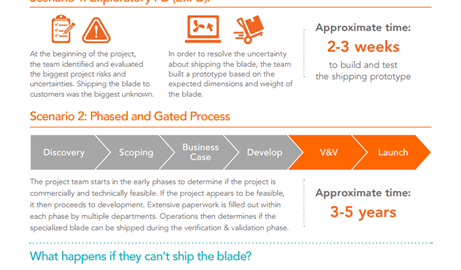Product developers are under tremendous pressure these days. Executives in product development are asked to bring new products to market faster while being smarter about choosing which projects to pursue. To top it off, their R&D budgets and the size of their product development staffs are decreasing.
With reduced resources, businesses are finding it harder to jump through all the hoops between a product idea and its market. Lack of resources and bureaucratic complexity can hold up a project for months, costing millions of dollars in lost sales revenue.
Pressures like these are not going away any time soon. We have been advising clients experiencing these pressures over the last twenty-five years, and we have witnessed their daily frustrations. Common themes we see across many companies include missed launch dates, missed sales goals, internal conflict, budget overruns, and the wrong products released to the marketplace. Often the most common stressor is a feeling of uncertainty: are we doing the right thing?
At first, to address those problems, we implemented phased-and-gated processes, the traditional best practice product development system. Companies saw improvements on many measures, but still we heard some common complaints. Our clients told us that when they followed the traditional phased-and-gated process, they experienced burdensome documentation, a slow pace, and creativity killing rigidity.
For us, the straw that broke the camel’s back came in the form of a very dissatisfied R&D director at a Fortune 500 company where we assisted in the design and implementation of a traditional phased-and-gated process. While the director accepted that the phased-and-gated approach would provide helpful structure, he was particularly resistant to its adoption, determining that it would be too slow and insufficiently adaptable to the ebbs and flows of his business. Additionally, he lacked sufficient resources to complete the comprehensive documentation that the process required. Even if the documentation requirements could be fulfilled, he personally could not allocate enough time to meet his gatekeeper obligation for review.
But if the industry standard best practice—the phased-and-gated approach—wasn’t the best methodology for his company, what was? At the time, there were no good alternatives. That’s when we went to work in earnest on the development of our new approach. We knew product development could be improved, and now we have the answer: Exploratory PD® (ExPD), a two-pronged approach to improving product development. Exploratory PD treats product development as a system with all elements fully integrated, and it offers a fundamental redesign of the development process based on reducing uncertainties and risk.
Prong 1: The Product Development System
Some academics and practitioners have tried to simplify product development into two neat, pithy phrases: “choosing the right project” and “doing the project right.” These statements oversimplify the goal and imply that the work, coordination, and decisions involved in choosing the right projects and doing the projects right are simple and straightforward. The truth is product development is much more than these two tasks, and to see that, we only need to look at who is involved in product development.
Virtually every department in an organization is touched by product development, meaning that multiple people, functions, processes, and infrastructures must be coordinated. As a result, product development is complex and needs to be managed as a system. In consulting with clients, we have always treated product development as a system, integrating these important elements: strategy, market understanding, process, teams and organization, portfolio management, and metrics.
In contrast, traditional best practice systems don’t treat product development as an integrated system. Managers, pressed for time and resources tend to limit their focus to just the product development process. And that causes many of the problems we see:
- Lack of a strategy to guide product development.
- Insufficient understanding of the market to identify important customer problems.
- Lack of a defined and strategically integrated portfolio management system which leads to the selection of the wrong projects.
- Inadequate infrastructure of tools and metrics to support product development.
- Lack of clear roles and responsibilities for both the project and executive team.
- Organization, team structure, and culture that are unaligned with the goals of product development.
When developing Exploratory PD, we sought to develop a comprehensive approach that addresses and integrates these important system elements.
Prong 2: The Product Development Process
Another way in which Exploratory PD’s two-pronged approach differs from the traditional processes is in its fundamental redesign of the development process in order to reduce uncertainties and risk. Traditional phased-and-gated processes address risk by spelling out every step of the process with prescribed activities: who is responsible, what deliverables should look like, and how decisions are made. The idea is to make sure nothing is missed; it’s a means of reducing the risk of failure and loss from poor project implementation and decision making. But this approach creates its own risks.
Being slow when the rest of the world is changing quickly from globalization, increased competition, and new technologies carries its own set of risks. You can lower profits if you miss opportunities or release outdated products. If you delay activities and decisions to specific points in the process, you run the risk of wasting resources on projects that should be killed. In sum, the typical focus on avoiding project risk misses a needed focus on myriad other risks. You need a new way of managing risk, all risk.
A short case study on the differences between the phased and gated process and Exploratory PD (Figure 1) is illustrated below.
Business & Finance Articles on Business 2 Community
(101)







